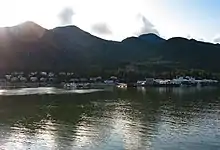
Klemtu is an unincorporated community on Swindle Island in the coastal fjords of British Columbia, Canada. It is located on Kitasoo Indian Reserve No. 1.[1]

Klemtu is the home of the Kitasoo tribe of Tsimshians, originally from Kitasu Bay, and the Xai'xais of Kynoch Inlet,[2] extends eastward from Queen Charlotte Sound, approximately at 52°46′03″N 128°06′25″W / 52.767462°N 128.10688°W. It is adjacent to the Fiordland Conservancy. These two tribes live together as, and are jointly governed by, the Kitasoo/Xai'xais Nation. Traditional languages spoken at Klemtu are the southern dialect of the Tsimshian language, called Southern Tsimshian, and Xaixais, a dialect of the Heiltsuk language. In religious affiliation, the community is dominated by the United Church of Canada.
The government of the Kitasoo/Xai'xais Nation is a member government of the Oweekeno-Kitasoo-Nuxalk Tribal Council.
The population of Klemtu in 1983 was 269. As of 2007 the population of Klemtu was 505.
Name origin
An alternate older name for Klemtu is Kitasoo.[3] it was also known as China Hat due to the shape of Cone Island, which protects it from the open water. The name Klemtu is from the Coast Tsimshian language "Klemdoo-oolk," meaning "impassable".[4]
See also
References
- ↑ "Klemtu". BC Geographical Names.
- ↑ Kynoch Inlet
- ↑ "Kitasoo". BC Geographical Names.
- ↑ "Klemtu". BC Geographical Names.
External links
Bibliography
- Inglis, Gordon B., et al. (1990) "Tsimshians of British Columbia since 1900." In Handbook of North American Indians, Volume 7: Northwest Coast, pp. 285–293. Washington: Smithsonian Institution.
- Miller, Jay (1981) "Moieties and Cultural Amnesia: Manipulation of Knowledge in a Pacific Northwest Coast Native Community," Arctic Anthropology, vol. 18, no. 1, pp. 23–32.
- Miller, Jay (1982) "Tsimshian Moieties and Other Clarifications," Northwest Anthropological Research Notes, vol. 16, no. 2, pp. 148–164.